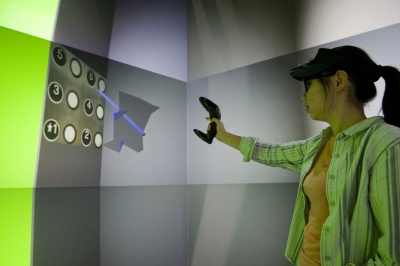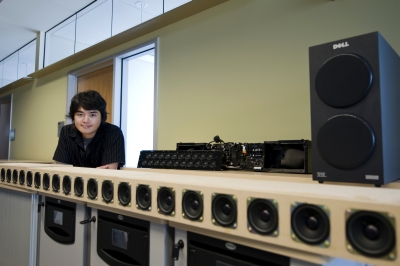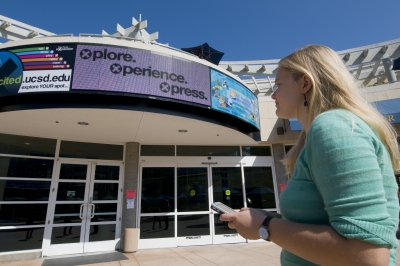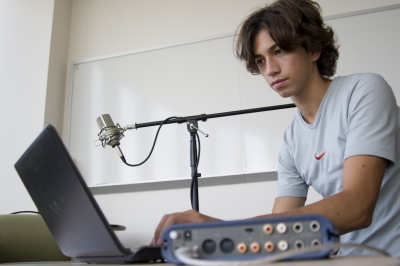Summer Scholars Take 'Audio-Visual' Research to the Next Level
By Maureen C. Curran
San Diego, CA, September 5, 2008 -- The thirty Calit2 UCSD Summer Scholars are finishing their summer of hands-on research. Their projects reflect a wide variety of subjects in more than 19 different fields. Here's a closer look at four projects which took seeing and hearing to new levels.
3-D Model of Atkinson Hall
Building on an existing project in the Calit2 Immersive Visualization Lab, Mabel (Mengzi) Zhang has been working on creating a 3-D model of Atkinson Hall (the Calit2 building) and making it as realistic as possible. When she started, the model was static and had just the first and second floors. Over the summer, she added the remaining four floors, the staircases and elevators and, most significantly, interactive elements, such as fully operational elevators and doors that open and close. Towards the end of the summer, aspects of realistic lighting began to be included in the model, an interactive indoor light and two types of sunlight effects were implemented.
"Mabel has done an amazing job teaching herself 3-D Studio Max, the 3-D modeling tool that we use in our lab," said her advisor, Jürgen Schulze, a Calit2 project scientist, "And she has diligently researched on the internet how to add interactivity to the 3-D model. I'm very pleased."
So is Zhang. "Simply put, what I say to myself is, I get to play everyday and get paid," said an enthusiastic Zhang, "My project allowed me to do so many things that I like to do. I have been doing general computer graphic design as a hobby for a long time. But now, having experienced it in a professional setting, I was able to see some high-tech wonders, such as virtual reality, and the possibilities they can bring, not just for entertainment, like games, but for actual scientific research."
|
"Doors that open up when the user gets in front of them is a feature that our collaborators from the Neurosciences department requested," Calit2's Schulze explained, "They use the model for user studies in which subjects wear an EEG cap which records brain activity during way-finding operations."
Progress towards more realism in the future will include lighting which simulates the time of day at the time a user visits the virtual building. They are also planning on adding functional light switches and incorporating sensor data that exists on the state of the various electric and electronic systems in Atkinson Hall. Zhang will begin her second year as a computer science major in a few weeks.
Wave Field Synthesis
Toshiro Yamada, an Interdisciplinary Computing and the Arts (ICAM) major, investigated the practical uses of wave field synthesis (WFS), an emerging sound reproduction technique that is capable of producing a 3-D sound field. WFS is often regarded as the next generation in surround-sound systems.
"This experimental technology offers a means to precisely control auditory imaging, even in complex and highly reflective environments such as Calit2's StarCave," explained Yamada's advisor, Peter Otto, a professor of music and Calit2's director of Sonic Arts. WFS uses a long array of closely-spaced loudspeakers to artificially construct a wavefront of a virtual auditory source.
|
For this hardware and software design project, Yamada built and implemented a Wave field Synthesis speaker array. His very successful (according to Otto) senior project had been an early stage custom implementation of such a system. Yamada used his new array to better understand the WFS technique and to investigate its application in Calit2's StarCAVE virtual reality system. He created a field simulation program to analyze the performance of various WFS algorithms and setups. The results provided new insights into possible WFS configurations in the StarCAVE.
"The research was exciting, but not easy," noted Yamada, "However, it gave me a clearer idea of what it really takes to be a researcher and what it is like to be a graduate student."
Yamada added, "This opportunity also allowed me to work closely with my advisor, Professor Peter Otto, and build an invaluable relationship with him." Yamada, who just graduated in June, continued, "I don't think there's any time as an undergraduate where you can see a professor everyday and constantly receive feedback on the work you're doing."
|
GridMouse - Manipulating Large Public Displays
Anna Ostberg studied how best to use a cell phone to quickly and efficiently manipulate information on a large interactive public display. Her goal was for users to be able to employ the familiar interface of their cell phone to conveniently, accurately and quickly navigate and interact with large dynamic displays. She and her advisor, Bill Griswold, a professor of computer science and engineering, created GridMouse, a cell-phone-based mouse program.
"Anna did a great job. We have a fully working implementation of GridMouse, and she is designing a protocol for a user study," said Bill Griswold, her faculty advisor, "We will likely be comparing the speed and accuracy of GridMouse versus using a commercial Gyroscopic mouse, as well as against using the "track stick" found on many mobile phones."
"My hope is that these usability tests will yield insights that can lead to new design iterations, which could then be evaluated in new user studies," Ostberg said, "Overall I think the project went well. I now have a very good design to evaluate in the coming months. There is certainly a lot more that can be learned from conducting further usability tests." Ostberg, a cognitive science major, will begin her senior year later this month.
|
Communicating Abstract Sound
Mason Bretan researched the interpretation of sound through cochlear implants. A cochlear implant is a prosthetic substitute for hearing. It is a surgically- implanted electronic device that can provide a sense of sound to a person who is profoundly deaf or severely hard of hearing, (it is not effective in all cases).
Bretan, an ICAM major, focused on how music and other abstract sounds are received by cochlear implant users, working with his advisor, David Borgo, an associate professor of music.
"Unfortunately what I found is that sound analysis and interpretation are not very good through these devices," Bretan said "So, I experimented with ways to improve upon them and provide a better experience for the user."
For the bulk of the summer project, he experimented with Fourier analysis and multiple types of filters to break down a sound sample into smaller components in order to isolate the bad noise and remove it. His hypothesis was that having multiple signals of a sound source with each signal spanning a specific frequency range would prove to be more effective than a single channel in finding and removing unwanted noise.
"Even if I did not discover a way for the deaf to hear music cleanly through cochlear implants and in the way in which naturally hearing persons are accustomed," Bretan summed up, "I still learned a great deal and made vast improvements in my research and programming skills."
Expressing the feelings of most of the 30 Summer Scholars, Bretan said "Overall, my summer experience was quite enjoyable and I would consider it a success. It was definitely a good experience and I liked the fact that I got to make specific research goals on my own and work towards these goals by myself, but always with the guidance of an advisor and Calit2."
Please join us for the Summer Scholars 2008 Poster Session and Reception on Tuesday, September 23, 2008 in the foyer of Atkinson Hall from 3-5 p.m. The event follows the open Calit2 Staff meeting which will be held in the auditorium from 2-3 p.m.; during the staff meeting four of the Summer Scholars will give presentations on their projects.
Related Articles
Calit2 Collaborates with Architects and UC San Diego Neuroscientists to Study How 'Way-Finding' Affects the Brain
Kickoff Week for the 2008 UCSD Calit2 Summer Undergraduate Scholars





